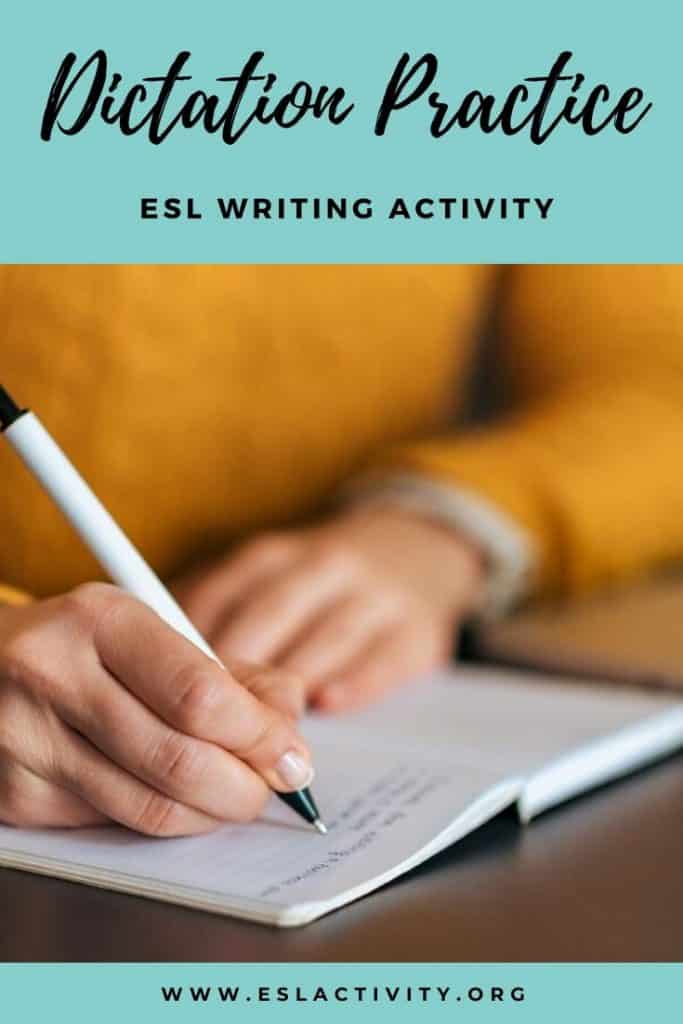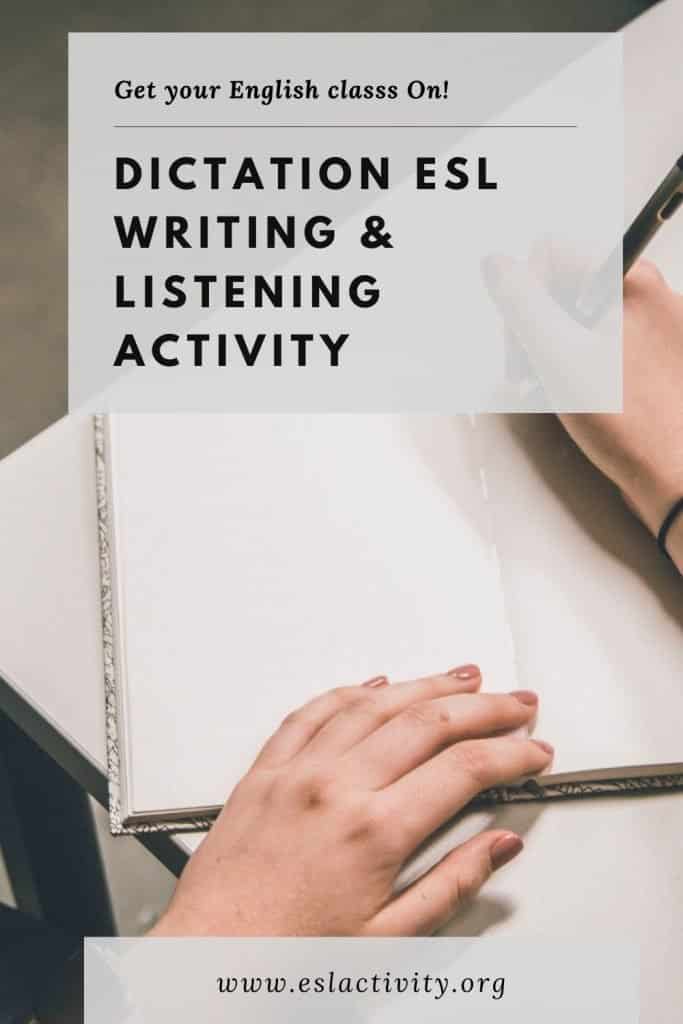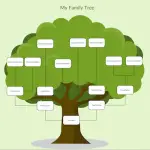Are you looking for a simple writing and listening activity that you can use for just about any level of English learner? Then dictation practice should certainly be an ESL activity that you consider. Keep on reading for all the details about how to do it with your students and get ready for some ESL teaching gold!

Dictation ESL writing activity
Here’s everything you need to know about ESL dictation.
Dictation ESL Writing and Listening Activity
Skills: Listening/writing
Listening Sub-Skills: Detecting transition signals, note taking, listening for detail, using context to anticipate what comes next
Time: 5-10 minutes
Level: Beginner-advanced
Materials Required: A text to dictate
Dictation can help our students with some important sub-skills, including detecting transition signals (first, second, third, etc.), note taking, and listening for details. It also helps students practice a range of other things, from printing English letters to punctuation, spelling, proof-reading and lay-out.
Dictation can also offer a serious dose of syntax, vocabulary and grammar! In short, it’s an extremely versatile activity. It’s also a nice break from the very communicative activities that dominate most of our textbooks and classes today.
I love to use it for frequency adverbs. I dictate either a question or answer and when students have finished writing them down, they have to write the question if an answer and vice-versa.
The way it works is that you find a writing passage that you’ll read to your students. Or, you could even make up your own on the fly for a truly no-prep activity. In an emergency situation, just grab something off the shelf in the teacher’s office or from your desk and it should work in most cases.
Consider the Textbook or Breaking News English for ESL Dictation Passages
However, if you have a wee bit more time, some good sources for writing passages are the textbook you’re using for the class, a website like Breaking News English, or just about anything for that matter! You may even want to write it yourself. The key is finding something at a similar level to your students, or just slightly below.
Read out the passage to your students who write down what they hear. You may have to read it again, depending on the level of your students.
I generally give students a minute or two at the end for proofreading and instruct them to check things like spelling and punctuation. Check answers and correct any errors with spelling, punctuation, etc. Or, you can write the passage on the board or online and students can check their own answers.
- Amazon Kindle Edition
- Bolen, Jackie (Author)
- English (Publication Language)
- 86 Pages - 12/08/2019 (Publication Date)
Teaching Tip for Lower-Level Students ESL Dictation
If you’re teaching beginner level students, it may be a good idea to type out your dictation with single-word fill in the blanks in each sentence. You may even put two possible answers in parentheses after each blank. For example, “Jackie goes to __________ (the beach, the beats).”
If you’re feeling really motivated, and have the time and energy, you can also try making a dictation worksheet with words that only have prefixes and suffixes. Then students must listen and complete the words. This is great for teaching spelling and you can help students learn how to listen/read parts of speech and their particular beginnings and endings.
Explain that if you know how different parts of speech are spelled, for example verbs often end with -ing, then you can more easily write down what you’re listening to. On tests, you can guess the meaning of a word more effectively if you know what part of speech it might belong to.
Teaching Tip for Higher-Level Students
For intermediate and advanced students, it’s important to help them learn skills like anticipating what comes next in the dictation. Teach and review briefly things like collocations (high frequency groupings of words) that students can use to reduce stress and anxiety when listening. Give an example like, “How are _____ _____? (you today). Tell students to think about the context of the listening dictation. Context + collocations can often help them fill in words they might have missed writing down.
Teaching Tip for Teaching Listening Strategies
Also, often the easiest and fastest way to find listening strategies to teach students is to break down into micro-skills and strategies what you would do if you were a student in your own class. If you really want to challenge students, paraphrasing or summarizing the dictation passage are incredibly useful skills. These skills are often weak or unpracticed for many of our students.
Ask students to write, for example, a summary of the dictation passage in one sentence that has the main idea and maybe a few key details. Be sure that you have a summary sentence of your own to show students as an ideal example if you do this.
Procedure for Dictation Writing Activity
- Choose a passage that you’ll read to your students.
- Read the passage and students have to write down what they hear.
- Give students some time for proofreading and then optionally, they can compare with a partner.
- If you have a digital copy of the dictation text on your computer, copy/paste it into a PPT slide. Put this up on the screen after the dictation for students to check their work.
- If you suspect that some/many students aren’t bothering to check and correct their errors, tell them you’re going to collect their papers and for every 3 uncorrected errors you find, they will lose a point from their participation grade at the end of the course. Or something along those lines. Most students will suddenly be extremely focused on checking their work for accuracy and fixing any errors they have made
Did you like this Dictation ESL Activity
- Amazon Kindle Edition
- Bolen, Jackie (Author)
- English (Publication Language)
- 116 Pages - 02/02/2020 (Publication Date)
Yes? Thought so. Then you’re going to love this book over on Amazon: ESL Listening Activities for Teenagers and Adults. The key to better English classes is a wide variety of student-centred, engaging and interesting TEFL activities and games and this book will help you with just that thing!
There are enough top-quality ESL games and activities to get through an entire semester of listening classes in style. Check out the book for yourself on Amazon but only if you want to get yourself a serious dose of some ESL teaching awesome in your life. Are you ready for it? Head over there now:
FAQs
There are a number of common questions that people have about using dictation with English learners. Here are the answers to some of the most popular ones.
What is dictation in language learning?
Dictation is an activity where learners listen to a passage or a series of sentences and write down what they hear. It helps develop listening skills, spelling, grammar, and overall language proficiency.
How can dictation benefit English learners?
Dictation can improve listening comprehension, spelling, vocabulary, grammar, and overall language accuracy. It also enhances focus, attention to detail, and note-taking skills.
How can I choose suitable dictation passages for English learners?
Select dictation passages that match the language proficiency level of your learners. Start with shorter and simpler sentences, and gradually increase the complexity as their skills improve. Choose topics that are relevant and interesting to engage their attention.
How can I conduct a dictation activity effectively?
Read the passage or sentences clearly at a moderate pace. Repeat each sentence or phrase as needed. Provide pauses for students to write, and then review the passage together, allowing students to check their work and make corrections.
Should I provide the written passage during dictation?
It depends on the purpose and level of the dictation. For beginners, you may provide a written passage to help them follow along. For more advanced learners, you can omit the written text and have them rely solely on listening and writing.
How can I support learners during dictation activities?
Break down the passage into smaller chunks, provide vocabulary assistance, and offer clarification if needed. After the dictation, discuss any challenging vocabulary or grammar points and address common errors.
How can I incorporate dictation into other language skills?
Dictation can be combined with other language skills. For example, after dictation, you can have students use the dictated sentences to practice speaking or writing. You can also use dictation as a springboard for discussions or creative writing activities.
How can I make dictation activities more engaging?
Use a variety of dictation formats, such as dictating dialogues, poems, song lyrics, or short stories. Incorporate interactive elements, like dictation games or dictation races, to add excitement and competition.
How often should I incorporate dictation in my lessons?
The frequency of dictation activities can vary based on your lesson objectives and the needs of your learners. It can be a regular part of your language lessons, but ensure you balance it with other activities to provide a well-rounded language learning experience.
How can I provide feedback on dictation exercises?
Provide immediate feedback after the dictation activity by reviewing the correct version of the passage. Address common errors, give explanations, and offer individual feedback on specific mistakes. Encourage self-correction and provide opportunities for students to compare their work.
Have your say about ESL Dictation, a Listening and Writing Activity
What are your thoughts about dictation? Is it a winner or do you have another writing or listening ESL activity that you’d like to recommend to us? Leave a comment below and let us know what you think. We’d love to hear from you.
Also be sure to give this article a share on Facebook, Pinterest, or Twitter. It’ll help other busy English teachers, like yourself find this useful resource.

Dictation practice ESL activity
Last update on 2022-07-17 / Affiliate links / Images from Amazon Product Advertising API






